冀教版英语八年级下册教案(全册)
- 格式:doc
- 大小:232.00 KB
- 文档页数:93
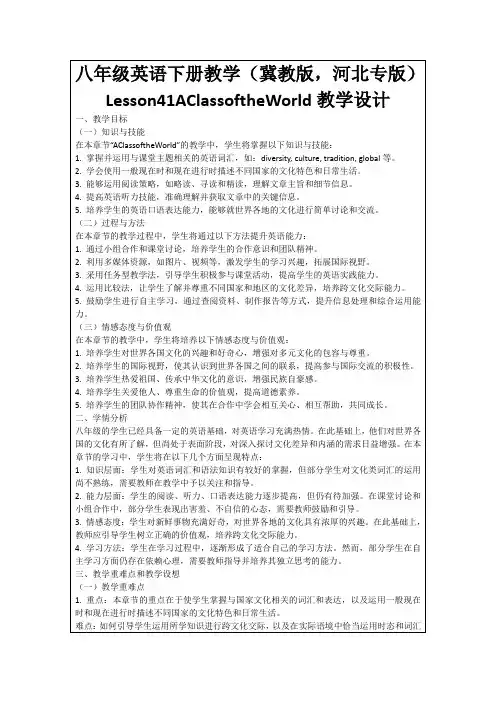
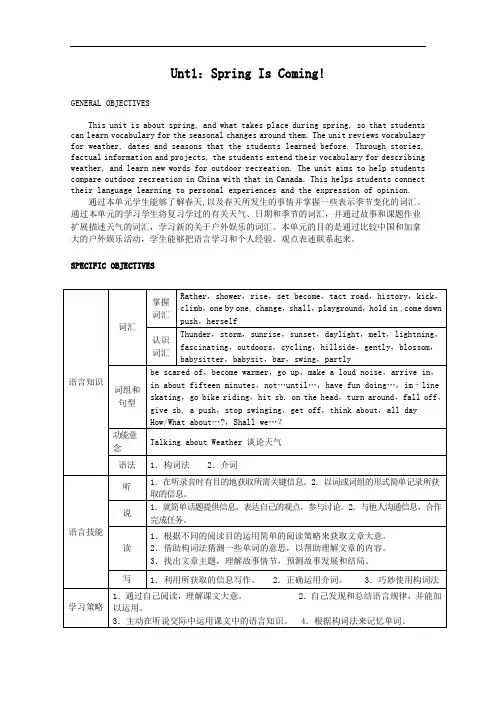
Unt1:Spring Is Coming!GENERAL OBJECTIVESThis unit is about spring, and what takes place during spring, so that students can learn vocabulary for the seasonal changes around them. The unit reviews vocabulary for weather, dates and seasons that the students learned before. Through stories, factual information and projects, the students extend their vocabulary for describing weather, and learn new words for outdoor recreation. The unit aims to help students compare outdoor recreation in China with that in Canada. This helps students connect their language learning to personal experiences and the expression of opinion.通过本单元学生能够了解春天,以及春天所发生的事情并掌握一些表示季节变化的词汇。
通过本单元的学习学生将复习学过的有关天气、日期和季节的词汇,并通过故事和课题作业扩展描述天气的词汇,学习新的关于户外娱乐的词汇。
本单元的目的是通过比较中国和加拿大的户外娱乐活动,学生能够把语言学习和个人经验、观点表述联系起来。
SPECIFIC OBJECTIVESLanguage knowledge﹡Master these words and phrases : rather, shower, rise, set﹡know these words and phrases: thunder, storm, sunrise, sunset.Class OpeningWelcome the students to come back to school. Introduce the new lesson and new students, Ask the students these questions : How is their winter holidays? Have they been anywhere? How did they spend the spring festival? what is the date today?What day is it today? What season is it? What is the weather like today? What is the temperature? Who is on duty today?Key Steps :Step 1 Ask the students to discuss the questions in “ Think About” If it is possible to show some pictures about different seasons.Step 2 . Let the students listen to the tape of the dialogue carefully with the following questions:What’s the weather like today? What’s the degree?Did Danny tell us what time the sun would rise and set?Step 3. Ask the students to read the dialogue several times in groups of three.Then ask them to act out the dialogue in groups,Step 4. Class Activity – Weather Map In this activity, Students will listen to the tape and make a weather map. Before this draw a simple map includes a city,a lake, the edge of the ocean, some mountains on the blackboard. Listen and draw.Class Closing :1) Ask the student to listen to the radio or watch TV for the next twenty-fourhours and write a weather report in English for at least eight cities.2) The next readingLesson 2 It’s Getting warmer.Language knowledge﹡Master these words and phrases : become ,fact﹡know these words and phrases: daylight , melt lightning, fascinating, go up, make a loud noiseClass OpeningAsk the student to read their weather report that they wrote according to the CCTV weather report. Then ask the same questions like yesterday.Key steps:Step1 Lead in such way : Ask How did they spend the spring festival? Was it cold during the Spring festival? Then say , “In today’s lesson, we will go on talking about the weather in spring. Can you name the four seasons in English? Ask the students to discuss and talk about the “Think About It” .Step2 Ask the students to read the text silently with the questions of exercises1 on activity books .Step3 Play the tape and ask the students to listen and read after the audiotape twice .Answer the questions to see if they can understand the text .Read the text one sentence by one sentence single. Then explain the problem they have. Pay attention to the phrases become warm , make a loud noise and so on.Step 4 Divide the students into two groups to do “ let’s do it “Step 5 Do some exercises on the activity books .Class closingread the text.The next readingLesson 3 Postcards!Language knowledge﹡Master these words and phrases : road, history, kick﹡know these words and phrases: outdoors, cycling, not…until…, have fun doing , in –line skatingClass OpeningAsk the students these questions : How is their winter holidays? Have they been anywhere? How did they spend the spring festival? what is the date today? What day is it today? What season is it? What is the weather like today? What is the temperature? Who is on duty today?Then read the text of lesson two and check the words and phrases they learned before two days.Lesson 4. Sun is rising.LESSON PREPARATl0NLANGUAGE KNOWLEDGE⊙掌握词汇及短语:climb,change,one by one⊙识别词汇及短语:hillside,gently,blossomLANGUAGE NOTES1.Weather is warming,…天气变暖和了,warm在这里是动词“变暖”的意思。
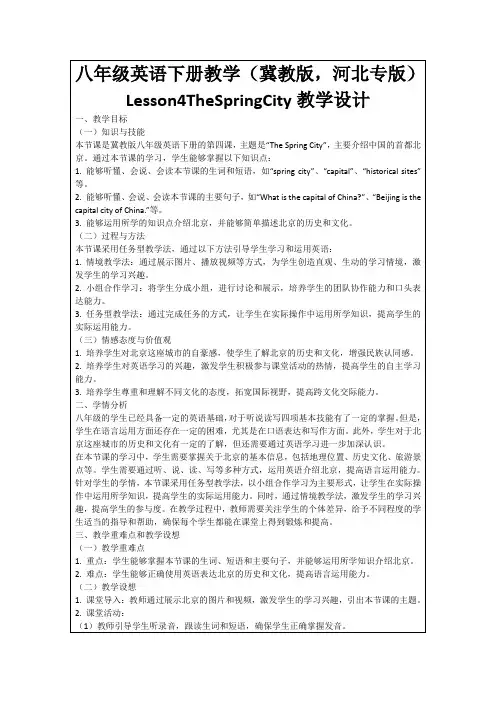
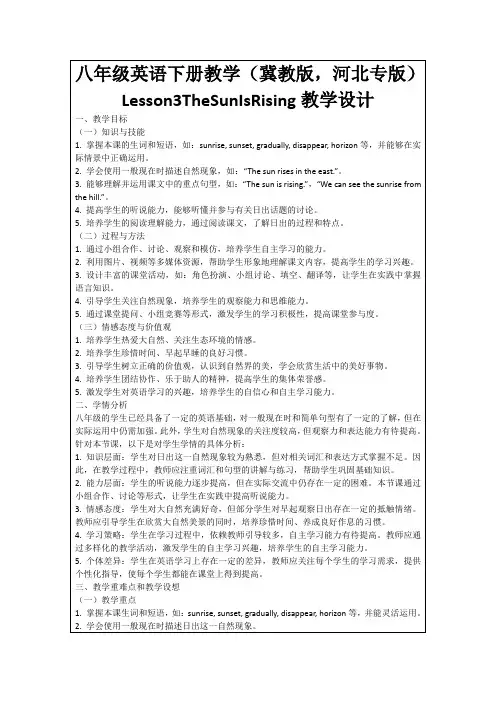
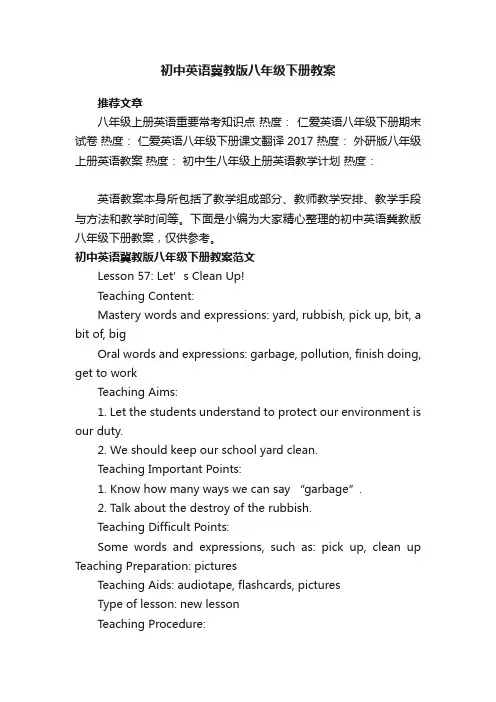
初中英语冀教版八年级下册教案推荐文章八年级上册英语重要常考知识点热度:仁爱英语八年级下册期末试卷热度:仁爱英语八年级下册课文翻译2017 热度:外研版八年级上册英语教案热度:初中生八年级上册英语教学计划热度:英语教案本身所包括了教学组成部分、教师教学安排、教学手段与方法和教学时间等。
下面是小编为大家精心整理的初中英语冀教版八年级下册教案,仅供参考。
初中英语冀教版八年级下册教案范文Lesson 57: Let’s Clean Up!Teaching Content:Mastery words and expressions: yard, rubbish, pick up, bit, a bit of, bigOral words and expressions: garbage, pollution, finish doing, get to workTeaching Aims:1. Let the students understand to protect our environment is our duty.2. We should keep our school yard clean.Teaching Important Points:1. Know how many ways we can say “garbage”.2. Talk about the destroy of the rubbish.Teaching Difficult Points:Some words and expressions, such as: pick up, clean up Teaching Preparation: picturesTeaching Aids: audiotape, flashcards, picturesType of lesson: new lessonTeaching Procedure:Step1. Come to “TALK ABOUT IT.”Step2. Show the new words to the students. Let the students read the words first. Then let them read after the tape.Step3. Listen to the tape and do Exercise 3 in activity book. Step4. Read the text and check the answers silently. At the same time, answer the following questions:1. Where are Jenny, Brian and Danny?2. How’s the weather?3. What do English people call “rubbish”?4. What is Jenny studying in class this week?5. What does the teacher think of Jenny’s idea?Step5. Read the text in roles loudly. Then let some students act it out in front of the class.Step6. PracticeExplain some language points to the class. Then ask the students to make up sentences with them.1. But look at all of the rubbish!2. Somebody should pick up that garbage!3. It would take too long.4. Each student could clean up a bit of the school yard.5. We would finish cleaning in an hour.Step7. Come to “LET’S DO IT.”Work in teams with three or four people. Let some students act their dialogue out in front of the class.Step 8. Homework1. Finish off the exercises in activity book.2. Go on the next reading in the student book.Summary:This lesson is close to our life. Try to take the students out of the classroom and show the garbage to them. Then let them saywhat they feel about the garbage. Ask them to act the dialogue out in the school yard. 冀教版英语八年级下册第八单元教案Lesson 57: Let’s Clean Up!Teaching Content:Mastery words and expressions: yard, rubbish, pick up, bit, a bit of, bigOral words and expressions: garbage, pollution, finish doing, get to workTeaching Aims:1. Let the students understand to protect our environment is our duty.2. We should keep our school yard clean.Teaching Important Points:1. Know how many ways we can say “garbage”.2. Talk about the destroy of the rubbish.Teaching Difficult Points:Some words and expressions, such as: pick up, clean up Teaching Preparation: picturesTeaching Aids: audiotape, flashcards, picturesType of lesson: new lessonTeaching Procedure:Step1. Come to “TALK ABOUT IT.”Step2. Show the new words to the students. Let the students read the words first. Then let them read after the tape.Step3. Listen to the tape and do Exercise 3 in activity book. Step4. Read the text and check the answers silently. At the same time, answer the following questions:1. Where are Jenny, Brian and Danny?2. How’s the weather?3. What do English people call “rubbish”?4. What is Jenny studying in class this week?5. What does the teacher think of Jenny’s idea?Step5. Read the text in roles loudly. Then let some students act it out in front of the class.Step6. PracticeExplain some language points to the class. Then ask the students to make up sentences with them.1. But look at all of the rubbish!2. Somebody should pick up that garbage!3. It would take too long.4. Each student could clean up a bit of the school yard.5. We would finish cleaning in an hour.Step7. Come to “LET’S DO IT.”Work in teams with three or four people. Let some students act their dialogue out in front of the class.Step 8. Homework1. Finish off the exercises in activity book.2. Go on the next reading in the student book.Summary:This lesson is close to our life. Try to take the students out of the classroom and show the garbage to them. Then let them say what they feel about the garbage. Ask them to act the dialogue out in the school yard.八年级英语复习题完型填空(10分)阅读下面短文,根据短文内容从每小题A、B、C、D中选出能填入空白处的最佳答案。
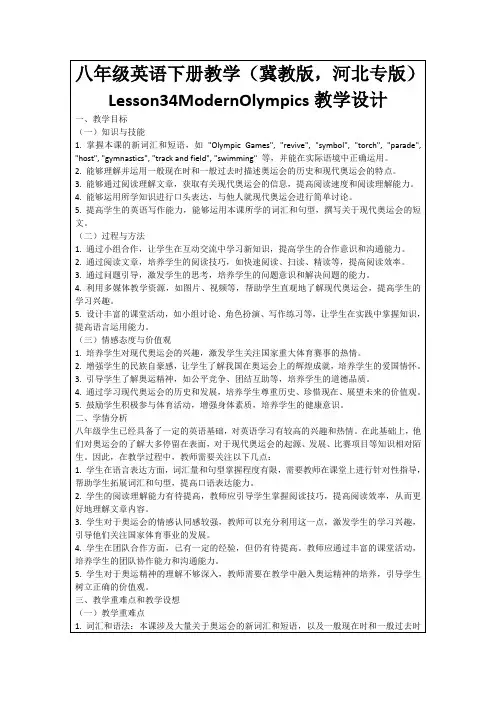
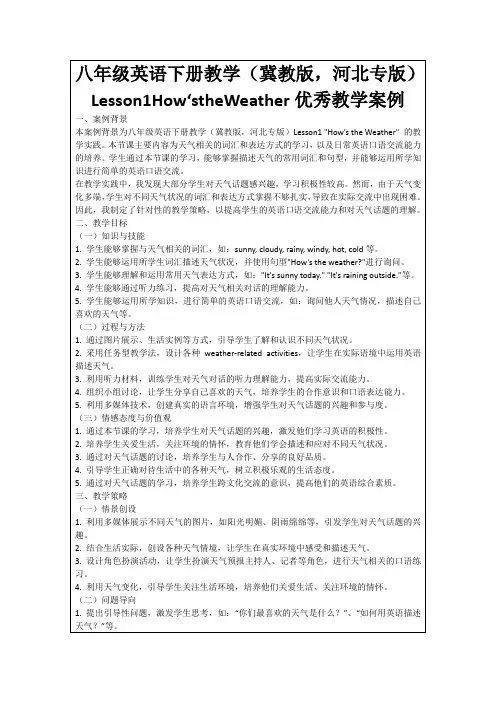
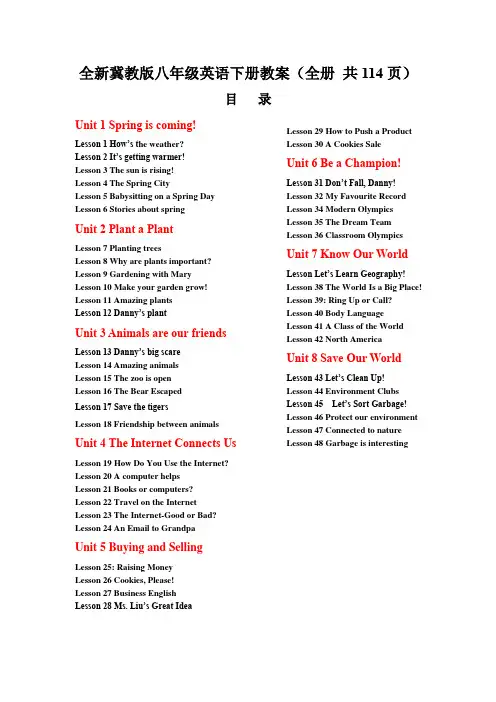
全新冀教版八年级英语下册教案(全册共114页)目录Unit 1 Spring is coming! Array Lesson 1 How’s t he weather?Lesson 2 It’s getting warmer!Lesson 3 The sun is rising!Lesson 4 The Spring CityLesson 5 Babysitting on a Spring DayLesson 6 Stories about springUnit 2 Plant a PlantLesson 7 Planting treesLesson 8 Why are plants important?Lesson 9 Gardening with MaryLesson 10 Make your garden grow!Lesson 11 Amazing plantsLesson 12 Danny’s plantUnit 3 Animals are our friendsLesson 13 Danny’s big scareLesson 14 Amazing animalsLesson 15 The zoo is openLesson 16 The Bear EscapedLesson 17 Save the tigersLesson 18 Friendship between animalsUnit 4 The Internet Connects UsLesson 19 How Do You Use the Internet?Lesson 20 A computer helpsLesson 21 Books or computers?Lesson 22 Travel on the InternetLesson 23 The Internet-Good or Bad?Lesson 24 An Email to GrandpaUnit 5 Buying and SellingLesson 25: Raising MoneyLesson 26 Cookies, Please!Lesson 27 Business EnglishLesson 28 Ms. Liu’s Great IdeaUnit 1 Spring is coming!Lesson 1 How’s the weather?◆教材分析本节课是冀教版初中英语八年级下册第一单元lesson1,功能话题是谈论天气;文本结构是对话;语法重点是初步认识合成词,并能够运用将来时态预测天气,以及正确使用will写简短的天气预报。
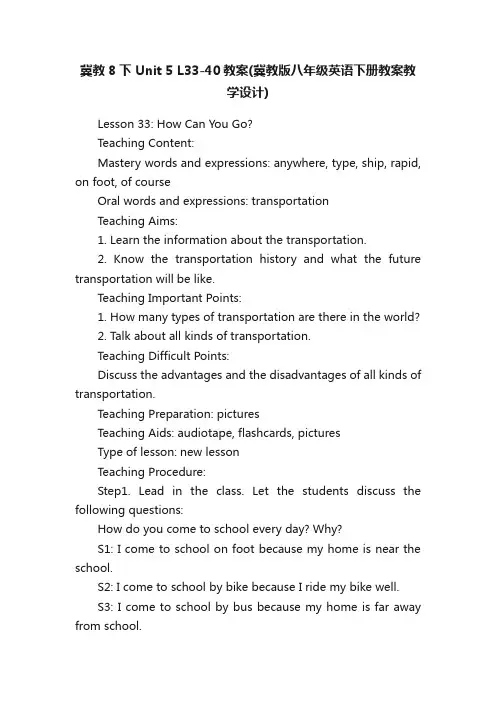
冀教8下 Unit 5 L33-40教案(冀教版八年级英语下册教案教学设计)Lesson 33: How Can You Go?Teaching Content:Mastery words and expressions: anywhere, type, ship, rapid, on foot, of courseOral words and expressions: transportationTeaching Aims:1. Learn the information about the transportation.2. Know the transportation history and what the future transportation will be like.Teaching Important Points:1. How many types of transportation are there in the world?2. Talk about all kinds of transportation.Teaching Difficult Points:Discuss the advantages and the disadvantages of all kinds of transportation.Teaching Preparation: picturesTeaching Aids: audiotape, flashcards, picturesType of lesson: new lessonTeaching Procedure:Step1. Lead in the class. Let the students discuss the following questions:How do you come to school every day? Why?S1: I come to school on foot because my home is near the school.S2: I come to school by bike because I ride my bike well.S3: I come to school by bus because my home is far away from school.Step2. Let the students ask questions about the transportation. Such as: what do you take if you go on a trip to Beijing? Why? Can you describe your favourite trip to the class?Step3. Listen to the tape and do with Exercise 2 in the activity book with the books closed.Step4. Read the text and check the answers. Then read the text again and repeat after it. After a while, ask some students to read the text loudly in roles.Step5. Make sentences with the phrases: what about, on foot, take a car, would like, more rapidStep6. PracticeDiscuss the following question:What is the advantages and disadvantages of the transportations? Such as: cars, trains, and buses. If you go on a trip, where would you like to go? How will you go there?Let the students work in groups of three of four. After a while, present their answers to the class.Step7. Come to “ LET’S DO IT.”Ask the students to talk in the class. Then they can give their presentation in dialogues or in composition. Encourage them to report one by one.Step8. Homework1. Finish off the activity book.2. Go on the next reading in the student book.Summary:When the students make their presentation to the class. Remember to remind them to speak in turn. We should let all the students have the chances to speak. If someone can’t go on, the others may help him.Lesson 34: Trains Go on Rails!Teaching Content:Mastery words and expressions: invent, wheel, engineer, railway, passenger, speed, even, get on/offOral words and expressions: rail, invention, steam, engine, locomotive, explode, distance, iron, per, magnetic, jet, jet engine, get on/off, (at) a top speed ofTeaching Aims:1. Know about the train history.2. What will the future train be like?Teaching Important Points:The invention of the steam engine, the first steam locomotive, railways and the first passenger.Teaching Difficult Points:Who invented the inventions and when did they invent them.Teaching Preparation: picturesTeaching Aids: audiotape, flashcards, picturesType of lesson: new lessonTeaching Procedure:Step1. Come to “THINK ABOUT IT.”Let the students talk in groups about the question: How do you usually travel to some other places?After discussing for a while, the students make a report to the class.Step2. Let the students read the text then answer how is the text arranged.Step3. Listen to the tape. After repeating the text for several times, ask them to retell the story in their own words.Step4.Let the students talk more about the trains. They may talk about their experience on trains. They also may talk about the structure of the trains, the use of the trains and the future ofthem.Step5. Make a table. Make a survey about the advantages and the disadvantages of the trains, the cars, the bus, the bicycles and the planes.transporation advantage disadvantagestraincarbusbicycleplaneStep6. Come to “LET’S DO IT”.Step7. Homework1. Finish off the activity book.2. Go on the next reading in the student book.Summary:The students know little about the train history. The teacher should arrange much information about it. Show them more pictures and let them know more. Encourage them to imagine the future transportation. Stimulate them to work hard and make their mind to make contribution to the worldLesson 35: Future TransportationTeaching Content:Mastery words and expressions: certainly, invention, present, round, wing, dangerous, factory, humorous, as long as Oral words and expressions: presentation, Henry, Ford, North America,Teaching Aims:1. Learn the history of the cars.2. Describe one type of transportation in the future.展开全文阅读Teaching Important Points:1. Learn about the Danny wheels.2. Imagine what types of transportation will be like from one hundred years now.Teaching Difficult Points:Let the students think and be creative.Teaching preparation: picturesTeaching Aids: audiotape, flashcards, picturesType of lesson: new lessonTeaching Procedure:Step1. Let the students talk about something about the planes and the cars. What do they know about the planes and the cars? If they know, let them say their details.Step2. Ask the students to talk about the picture in the text. What do they think about this?Step3. Let’s listen to t he tape and answer the following questions:1. How did people get to another city before people invented plane?2. When did Henry Ford open a car factory?3. What’s Danny’s invention?4. Would someone like to ride in the Danny’s wheel? Why?Step4. Read the text and check the answers. Then let the students read it loudly in class. After a while, ask the students read the text in roles.Step5. Let the students act he dialogue out. They can take a circle for Danny’s wheel.Step6. Ask some students to make sentences with the following phrases:At that time, need to, present, you’d better not.At that time, I was a little girl.You need to wear warm clothes in cold winter.Present your invention to the class.You’d better say it again.Step7. Come to “PROJECT”.1. Ask the students to make a survey: ask your grandparents about the old transportation. When they are in a hurry, what did they do? Did they think of the modern transportation today? What do they think of the life today?Remember to make a report to the class.2. Talk in groups of three or four. What do you hope the future transportation will be like? Can you invent some useful invention? Report to the class.3. Make a detail about your future transporation.Step8. Homework1. Finish off the activity book.2. Go on the next reading in the student book.Summary:Encourage students to make a survey about the old transportation. How did our grandparents go to a big city in the old days? How long did it take? While, we think hard to invent new transportation. What’s its advantages and disadvantages? We can make a detail about it.Lesson 36: Let’s T ake a DriveTeaching Content:Mastery words and expressions: drive, countryside, rideOral words and expressions: drove, driven, highway, rode, ridden, park, afarTeaching Aims:1. Feel the charming of the music.2. Know what the people in the foreign countries do in theirspare time.Teaching Important Points:1. Sing the foreign songs together.2. Use the modal verbs.Teaching Difficult Points:Grasp some words and patterns: be late for, get out of, you’d better notTeaching Preparation: picturesTeaching Aids: audiotape, flashcards, picturesType of lesson: new lessonTeaching Procedure:Step1. Listen to the tape first. Feel the charming of the music.Step2. Ask the students to read the lyric line by line. Divide them into several groups to practice the song.Step3. Explain the Chinese meaning of the song. Your translation must be like poem in order to take them to a beautiful situation.Step4. Listen to the tape for several times and repeat with it.Step5. Work in groups. Talk about the questions:1. What do you usually do in your spare time? How do you usually go there? Why?2. Talk about your recent journey to the class. What gave your most expression?Step6. Practice1. the use of modal verb “can”.Can you drive me to school today?Can he go to my home?2. the use of modal verb “may”.May I speak in Chinese?May I leave school now?3. You’d better not.--May we eat take a photo here? –You’d better not. Look at “NO PHOTOS” sign.--May I smoke? –You’d better not. Look at “NO SMOKING” sign.Step7. Homework1. Finish off the activity book.2. Go on the next reading in the student book.Summary:Today we learn a song. After a piece of music, we feel a mother’s love. Mrs. Dinosaur’s voice is very interesting, which becomes the modal of some students. We deal with the two modal verbs “can and may” again. Now we know it’s used to ask for permission.Lesson 37: Flying DonutsTeaching Content:Oral words and expressions: fuel, imaginationTeaching Aims:1. Stimulate students’ learning interests.2. Cultivate students’ listening by catching the useful information in the listening process.Teaching Important Points:1. Encourage students’ to increase creative ability.2. Why is th e invention called “flying donuts”.Teaching Difficult Points:What’s the theory of an invention?Teaching Preparation: picturesTeaching Aids: audiotape, flashcards, picturesType of lesson: new lessonTeaching Procedure:Step1. Play a GameLet some students explain it in English, while the others guess what it is. You must say the transportation. For example,A transporter is very long. It can hold many people in it. It can also take goods. What is it?Step2. Listen to the tape and answer the following questions:1. What is Danny’s invention made of?2. Why is it called “Flying Donuts”?3. Will Danny’s invention really work?Step3. Read the text and check the answers. Then listen to the tape again and read after it for several times.Step4. Ask the students to read the text in roles. Then act the dialogue in front of the class.Step5. Make sentences with the following language points: on the way to school, turn on, at the front ofStep6. Let’s come to “PROJECT”.Divide the class into small groups of three of four students. Each group chooses a type of transportation for the students. Instruct students to begin collecting information about that type of transportation. They will prepare a comic strip or timetable of important dates in its development.Groups present their work to the class. Depending on class size and the length of presentations, you may wish to divide up the class. Groups would then present their projects to one portion of the class.If the project cannot be finished in one class, it can be continued in the next lesson.展开余文Step7.Homework1. Finish off the activity book.2. Go on the next reading in the student book.Summary:Let the students create more useful inventions. When one group thinks of a good idea, the others can add their useful information to it. Instruct them to speak in timeline.Lesson 38: Let’s Invent Hoverboard!Teaching Content:Mastery words and expressions: smooth, second, space, soundOral words and expressions: Sam, hoverboard, skateboard, float, transportation, show, spaceship, all the time, go through Teaching Aims:1. Review words and phrases for transportation that the students learned before.2. Encourage the students to find and restate information in personal and imaginative ways.Teaching Important Points:1. How do you demonstrate your invention?2. Learn about the use of Modal Verbs.Teaching Difficult Points:the use of Modal VerbsTeaching Preparation: picturesTeaching Aids: audiotape, flashcards, picturesType of lesson: new lessonTeaching Procedure:Step1. Come to “THINK ABOUT IT”.Let the students answer the questions and discuss them in pairs.Step2. Listen to the tape and answer the following questions:1. What type of transportation would Sam like to see in the future/2. What would a hoverboard be like?3. What types of transportation are in this text?Step3. Read the text and check the answers. Then play the tape for several times. Let the students repeat after it for several times.Step4. Ask the students to have a reading content. Divide the class into several groups. Each group chooses one person every time. The one reads best can get a star. Let’s have a compete to see which group will have the most stars.Step5. Divide the class into several groups. Ask them to talk the future transportation that they would like to see. Use the words and the expressions that we learn in this unit.Step6. Come to “LET’S DO IT”.Step7. Homework1. Finish off the activity book.2. Go on the next reading in the student book.Summary:Let’s have a discussion about Sam’s invention. Will it come true one day? What do you think of it? What’s the students’ invention? This is a good chance to develop students’ brain. Don’t miss it.Lesson 39: Clean Cars?Teaching Content:Mastery words and expressions: sound, dirty, electricOral words and expressions: pedal, electricity, present…to…Teaching Aims:1. Learn about the words and expressions about the transportation.2. Know about the development of the transportation.Teaching Important Points:1. Grasp the modal verbs2. Talk about the possibility and impossibility.Teaching Difficult Points:Modal VerbsTeaching Preparation: drawingsTeaching Aids: audiotape, flashcards, drawingsType of lesson: new lessonTeaching Procedure:Step1. Lead in the class.The teacher sums the main idea of this unit: “ In this unit, we learn about the trains, bicycles, cars and the other transportation. What we want to see in the future? Yesterday we leave this as our project. Can you show it to the class now.”Then let the students show their drawings to the class. Ask the students to explain their invention in English to the class.Step2. Listen to the tape and answer the following questions:1. What did the teacher ask us to think about?2. What is Jenny’s invention?Step3. Read the text silently and check the answers. Let the students discuss the main idea of the passage in details.Step4. Listen to the tape again. Then let the students tell the main idea in their own words.Step5. Talk about Jenny’s invention. What do you think of her idea? Can you give her any good ideas?Step6. Come to the second e-mail.Ask the students the questions: Is Li Ming’s advice the same as the ideas that you give Jenny? Which one is better? Why?Step7. Come to “LET’S DO IT”.Step8. Homework1. If you don’t finish “LET’S DO IT” in class, please go onafter class.2. Finish off the activity book.Summary:You will be interested in the students drawing of future invention of the transportation. Many students have excellent imagination. Let them explain their invention in details. You will find out there are very clever. Maybe their invention will come true one dayLesson 40: Unit ReviewTeaching Content:Mastery words and expressions from Lesson 33 to Lesson 39.Oral words and expressions from Lesson 33 to Lesson 39.Teaching Aims:1. Know about the history of some transporters.2. Learn about the development of the future transportation.Teaching Important Points:1. Giving Advice/Order.2. Possibility and Impossibility.Teaching Difficult Points:Modal VerbsTeaching Preparation: picturesTeaching Aids: audiotape, flashcards, picturesType of lesson: Review lessonTeaching Procedure:Step1. Talk about the way of coming to school. Ask the students the questions:1. How do you come to school? Why?2. How many students in the class come to school by bike, by bus or on foot?Make a chart to show the information.By bike By bus On footNumberReasonStep2. Talk about the main idea of this unit. What advantages and disadvantages do the following transporters have? What do you do with the disadvantages? What’s your good opinion?By plane By train By bus By carAdvantagesDisadvantagesAdviceStep3. Think about the main ideas of this unit. Let the students say it in details. Talk about what would they like to see in the future about the transportation?Step4. Come to the exercises. Encourage the students to ask questions and discuss them on the blackboard.Step5. Lead the students to talk about the Modal Verbs. Make sentences with can, could, would, may and might.Step6. Come to the “Speaking the Language”.Step7. Come to the activity book.Step8. Do some review activities.Summary:Reviewing the main ideas of this unit is very main part of this lesson. We not only review the use of the main grammars: the Modal verbs, but also we should talk about the transportation again. The teacher can arrange some games about transportation in this lesson. Let the students grasp the language points in the activities.。
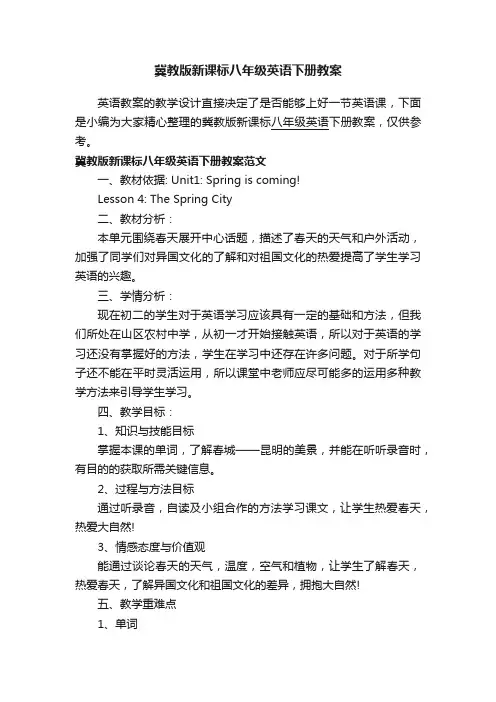
冀教版新课标八年级英语下册教案英语教案的教学设计直接决定了是否能够上好一节英语课,下面是小编为大家精心整理的冀教版新课标八年级英语下册教案,仅供参考。
冀教版新课标八年级英语下册教案范文一、教材依据: Unit1: Spring is coming!Lesson 4: The Spring City二、教材分析:本单元围绕春天展开中心话题,描述了春天的天气和户外活动,加强了同学们对异国文化的了解和对祖国文化的热爱提高了学生学习英语的兴趣。
三、学情分析:现在初二的学生对于英语学习应该具有一定的基础和方法,但我们所处在山区农村中学,从初一才开始接触英语,所以对于英语的学习还没有掌握好的方法,学生在学习中还存在许多问题。
对于所学句子还不能在平时灵活运用,所以课堂中老师应尽可能多的运用多种教学方法来引导学生学习。
四、教学目标:1、知识与技能目标掌握本课的单词,了解春城——昆明的美景,并能在听听录音时,有目的的获取所需关键信息。
2、过程与方法目标通过听录音,自读及小组合作的方法学习课文,让学生热爱春天,热爱大自然!3、情感态度与价值观能通过谈论春天的天气,温度,空气和植物,让学生了解春天,热爱春天,了解异国文化和祖国文化的差异,拥抱大自然!五、教学重难点1、单词2、短语及语法六、教法与学法小组讨论、合作探究、教师指导七、课型新授八、教学过程Step 1.Lead-inA warming-upA sayingStep 2.pictures show and new words, then, listeningShow some pictures about spring and learn the new words by playing a game, the do the listening about the text and answer one simple question.What is the spring city?It’s Kunming.Step 3.ReadingAsk several students to read the text and pay attention to the new words, the students read it again, and discuss together about the four questions in “Let’s Do It.part1”Step 4. ListeningDo the listening in “Let’s Do It!”part2, listen to it twice, and then invite some students to answer them.Step 5.DiscussingDivide the class into small groups; write the following words on the blackboard:Air /weather/ plants/ and outdoor activities.Step nguage points1. feel like /sound like / smell like / taste likefeel like doing sth.2. because and because ofBecause +句子Because of + n./pron./doing3. hundreds of /基数词+单位名词(hundred /thousand/million/billion)4. think of =consider5. all over the world =around the world6. all year round7. plenty of=a lot of =lots of8. long for= look forward toStep 6.Homework1、Write a short passage about spring in your hometown2、Preview Lesson 5Step 7.Summary:Review the text is very important. The students know what they will take to the class, what is useful to the study. Let them to talk about The Spring City. --- Its air, weather, plants and the outdoor activities in spring.九、板书设计:Lesson 4: The Spring CityAir weather plants and the outdoor activities十、教学反思:本节课在前几节课学习的基础上进一步来学习春天,通过运用多媒体向学生展示了春天的景色。
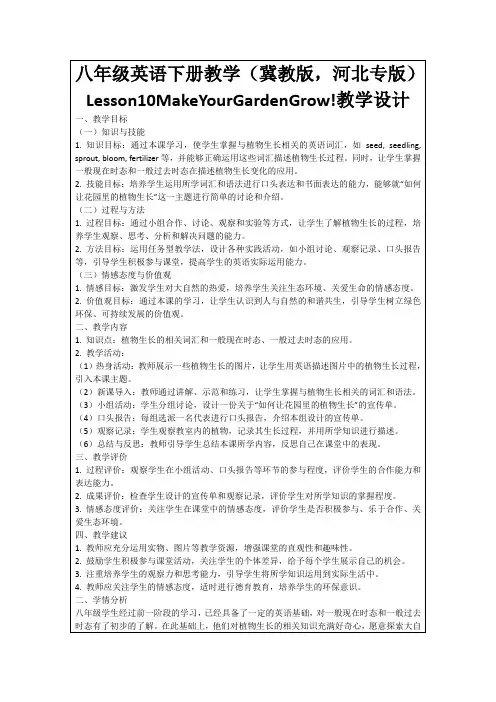
全新冀教版八年级英语下册教案(全册共155页)目录Unit 1 Spring is coming!Lesson 1 How’s the weather?Lesson 2 It’s getting warmer!Lesson 3 The sun is rising!Lesson 4 The Spring CityLesson 5 Babysitting on a Spring Day Lesson 6 Stories about springUnit 2 Plant a PlantLesson 7 Planting treesLesson 8 Why are plants important? Lesson 9 Gardening with MaryLesson 10 Make your garden grow! Lesson 11 Amazing plantsLesson 12 Danny’s plantUnit 3 Animals are our friends Lesson 13 Danny’s big scareLesson 14 Amazing animalsLesson 15 The zoo is openLesson 16 The Bear EscapedLesson 17 Save the tigersLesson 18 Friendship between animals Unit 4 The Internet Connects Us Lesson 19 How Do You Use the Internet? Lesson 20 A computer helpsLesson 21 Books or computers?Lesson 22 Travel on the InternetLesson 23 The Internet-Good or Bad? Lesson 24 An Email to Grandpa Unit 5 Buying and Selling Lesson 25: Raising MoneyLesson 26 Cookies, Please!Lesson 27 Business English Lesson 28 Ms. Liu’s Great Idea Lesson 29 How to Push a Product Lesson 30 A Cookies SaleUnit 6 Be a Champion! Lesson 31 Don’t Fall, Danny! Lesson 32 My Favourite Record Lesson 33 2800 Years of Sports Lesson 34 Modern Olympics Lesson 35 The Dream Team Lesson 36 Classroom Olympics Unit 7 Know Our World Lesson Let’s Learn Geography! Lesson 38 The World Is a Big Place! Lesson 39: Ring Up or Call? Lesson 40 Body LanguageLesson 41 A Class of the World Lesson 42 North AmericaUnit 8 Save Our World Lesson 43 Let’s Clean Up!Lesson 44 Environment Clubs Lesson 45 Let’s Sort Garbage! Lesson 46 Protect our environment Lesson 47 Connected to nature Lesson 48 Garbage is interesting.Unit 1 Spring is coming!Lesson 1 How’s the weather?◆教材分析本节课是冀教版初中英语八年级下册第一单元lesson1,功能话题是谈论天气;文本结构是对话;语法重点是初步认识合成词,并能够运用将来时态预测天气,以及正确使用will写简短的天气预报。
Unit 1Spring is Coming!Lesson 1: How’s the Weather ?(two periods)教案Teaching Content:Mastery words and expressions: rather, shower, rise, rose, risen, setOral words and expressions: thunder, storm, sunrise, sunsetTeaching Aims: Talking about the weatherTeaching Important Points:1.Describe the weather in spring;2.Talk about the temperature.Teaching Difficult Points:Describe the nature phenomenon.Teaching preparation: the pictures of springTeaching Aids: audiotape; flashcards; picturesType of lesson: new lessonTeaching Procedure:一、温故知新。
Check some words and phrases .二、激情导入。
Lead inFree talk:1.What weather do you like? Why or why not?2.What sports can you do in this season?三、新课学习。
Step 1: Showing the teaching aims on the blackboard and asking students to read them together.1.Remembering some new words and phrases of lesson 1 work in group.2.Talking about seasons.3.Understanding the dialogue meaning.Step2. Come to “THINK ABOUT IT”Let the students work in groups and answer the following questions:1.Look outside. Wh at’s the weather like today?2.How does this weather make you feel?Step3. Listen to the tape and answer the following questions:1.What’s the weather like today?2.It is snowing, isn’t it?3.what’s the temperature?4.Is it going to rain today, isn’t it?Step4. Read the text and check the answers. Read the text in roles.Step5. PracticeWork in three students. Suppose you are a weather reporter. Now report today’s weather to the others in your group. Then report it to the class. Step6. PracticeMake up a dialogue between two or three students in class. It is about the weather in spring. Let some students act it out before the class.四、达标训练,作业布置。
1.Find something that represents spring and show it to the class nexttime.2.Finish off the activity book.Lesson 2: It’s Getting Warmer!(two periods)教案Teaching Content:Mastery words and expressions: become, became, become, factOral words and expressions: daylight, melt, lightning, fascinating Teaching Aim:1.Know something more about spring;2.The compound words.Teaching Important Points:1.When does spring begin?2.How many hours of daylight are there on March 21st?3.What is the weather like?Teaching Difficult Points:the compound wordsTeaching Preparation: some pictures of springTeaching Aids: audiotape, flashcards, some picturesType of lesson: new lessonTeaching Procedure:一、温故知新。
Check some words and phrases .二、激情导入。
Lead inLet the students on duty reports the weather to the class. Theothers listen and decide it is right or wrong.三、新课学习。
Step 1: Showing the teaching aims on the blackboard and asking students to read them together.1.Remembering some new words and phrases of lesson 2 work in group.2.Talking about seasons.3.Understanding the dialogue meaning.Step 2:Listen to the tape and answer the following questions:1.What’s the date today?2.How many ways can you write dates?3.How many hours of daylight are there on March 21st?4.What is spring weather like?5.What is the temperature of the air near lighting?Step3. Read the text and check the answers.Step4. Listen to the tape again and imitate after it until they can read it fluently and correctly.Step5. Ask the students to ask other questions according to the text. You can begin like this:1.When does the sun rise in the morning and when does it set in theevening?2.Does it snow in early spring?3.What is sometimes with thunder and lighting?Step6. Come to “LET’S DO IT”.Work in groups and discuss these questions. Then let them report it to the class.四、达标训练,作业布置。
1.Finish off the activity book.2.Write a composition about spring.Lesson 3: : The Sun Is Rising(two periods)教案Teaching Content:Mastery words and expressions: one by one, changeOral words and expressions: hillside, gently, blossomTeaching Aim:Enjoy the beauty of the springTeaching Important Point:Grasp the changes that spring bring usTeaching Difficult Points:How to use “warm” and “gently”.Teaching Preparation: something that represents springTeaching Aids: audiotape, flashcards, pictures or flowersType of lesson: new lessonTeaching Procedure:一、温故知新。
Check some words and phrases .二、激情导入。
Lead inFree Talk:Let the students work in three and talk about the sports that we often do in spring. Then give a talk for the class.三、新课学习。
Step 1: Showing the teaching aims on the blackboard and asking students to read them together.1.Remembering some new words and phrases of lesson 3 work in group.2.Talking about seasons.3.Understanding the dialogue meaning.Step 2:Read the song aloud as a poem. This song has this song has common English words: come with me, through the trees, one by one, the flowers blossom. Translate these expressions into English.Step3. Play the audiotape and let the students just listen with the eye closed.Step4. Play the tape again and let the students sing with it.Step5. Explain the common English expressions.Step6. Practice the song a few times, with and without the audiotape. Step7. Come to “LET’S DO IT”.四、达标训练,作业布置。